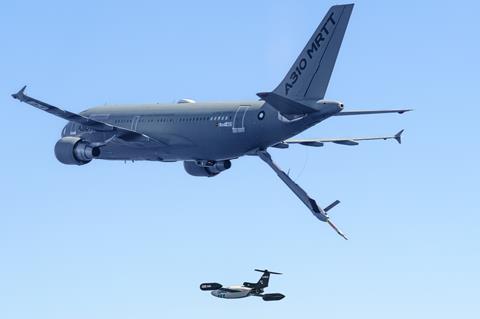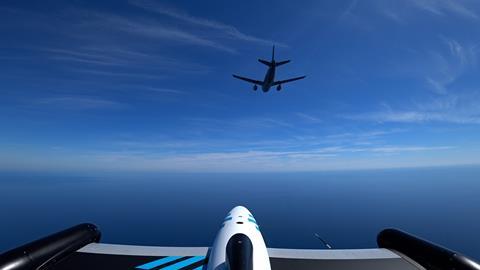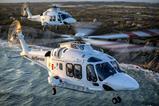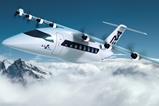Airbus Defence & Space has successfully demonstrated in-flight autonomous guidance and control of a series of unmanned air vehicles using an A310 Multi Role Tanker Transport (MRTT) flying testbed.
Seen as a first step to maturing autonomous formation flight and autonomous asset air-to-air refuelling (A4R) capabilities, the trials were carried out in the south of Spain in partnership with Airbus UpNext, the airframer’s innovation arm.

Airbus sees the refinement of such technologies as essential for the operation of next-generation combat aircraft, such as the manned and unmanned aircraft proposed under the tri-national Future Combat Air System (FCAS) programme in which it is a partner.
Known as Auto’Mate, the technologies were integrated onto a company-owned A310 MRTT and several DT-25 target drones – acting as receiver aircraft – launched from Airbus’s Getafe plant and the Arenosillo test centre in Huelva, respectively.
Performed over the Gulf of Cadiz on 21 and 23 March, each mission lasted 6h and involved the sequential launch of four DT-25s.
During the sorties, control of the drones transitioned from a ground station to the A310 MRTT, autonomously guiding each to the in-flight refuelling position, around 45m (150ft) behind the tanker.
Airbus says the receiver aircraft “were sequentially controlled and commanded thanks to artificial intelligence (AI) and cooperative control algorithms” without the need for human intervention.
“We are extremely happy with what we have achieved in an extremely short timeframe,” says Manuel Barriopedro, head of the Auto’Mate demonstration at Airbus UpNext. Plans for the flight-test effort were only detailed last year and the campaign concluded ahead of schedule, he notes.
“Although we are in a very, very early stage, we think we have performed our biggest step in order to continue developing these kind of operations,” adds Barriopedro.
Airbus says the demonstration rested on three technological pillars: accurate relative navigation – to determine precisely the relative position, speed and attitudes between the tanker and the receiver; in-flight communication between the platforms; and co-operative control algorithms for guidance and collision avoidance.

Sensors installed on the aircraft included LIDAR and multiple cameras with different fields of view, alongside several GPS-based navigation sources, such as real-time kinematics “through which we can have relative positioning of less than one centimetre”, says Barriopedro.
A second campaign is expected towards the end of 2023, exploring the use of navigation sensors based on AI and improved autonomous formation flight algorithms.
In addition, there will also be two simulated drones flying in the vicinity of the A310 MRTT to demonstrate multi-receiver autonomous operations and collision-avoidance technology.
Airbus is confident it can commercialise the A4R technology, enabling it to work in tandem with the automatic air-to-air refuelling system (A3R) it has already certificated for the A330 MRTT, which automates the final contact between the boom and receiver.
“My ambition here would be to have this system certified and available to the market before the end of the decade,” says Maria Angeles Marti, head of tanker and derivatives at Airbus Defence & Space.
No refuelling contacts with the drones are envisaged in the next round of testing, but Marti says Airbus wants to develop a “plug-and-play asset” that can be easily adapted for future operations.
While Singapore is the launch customer for the A3R system on its A330 MRTT fleet and has supported the development with its aircraft, Marti sees wider interest from other customers in taking advantage of the upgrade “off the shelf”.
However, it is “still to be decided” whether A3R could become a standard feature on new-build aircraft, she adds.































